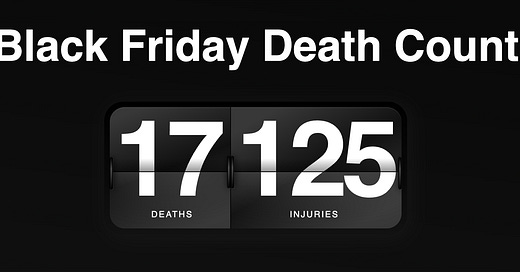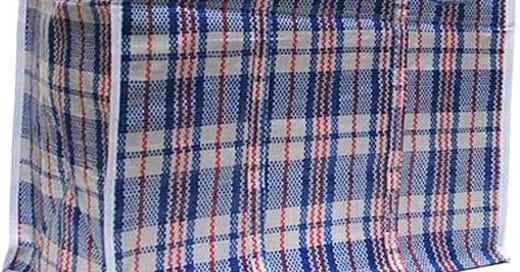

Discover more from Articles Of Interest
Happy Black Friday Week to all who are observing. I hope you’re finding good deals.
I suppose Black Friday (and the lead-up to it) has become something of Mass Consumption’s Official Holiday, having arguably (on the internet) eclipsed that other holiday about gratitude. And to celebrate, here is a little gift for you.
One of my very favorite places to learn and think about fashion is from my internet friend Em Seely-Katz. Their newsletter, Human Repeller, is full of wish lists, bargain roundups, excellent Halloween costume ideas, trend forecasts, and essays, all full of Em’s weirdo brilliant insight and wit.
So here, as a special treat for AOI readers, is an exclusive little essay from Em. About this day, and how it drives people wild.
Once upon a time, shopping included the possibility of bloodshed. A now-defunct, single-page website curtly titled “Black Friday Death Count” took the morbid responsibility of cataloging all injuries and fatalities on record resulting from sale-induced melees from 2006 to 2021.
The most famous Black Friday deaths were caused by stampedes, the first of which, at a Walmart in 2008, took the life of employee Jdimytai Damour and launched a thousand SNL jokes based on the idea that Black Friday shoppers were hordes of violent dullards (and, of course, poor).
This spectacle defined every November of my childhood, and my parents made sure I knew we were above participating in Black Friday. Between bites of Thanksgiving dinner, my family speculated that “they,” in a tone that said “the unwashed masses,” must already be lining up for their chance to fight their way through the crowds, risking their lives for a—the preferred metonymy—“flat screen TV.”
The overt classism of this ritualistic mocking became obvious to me in my teenhood, and I was instinctively defensive of the Black Friday hopefuls, especially those who attended such events not to buy a specific item, but to “shop the sales.” As a kid raised in capitalist America, I could feel the magnitude of their untethered desire.
I am not above this. I feel the urge to buy things. Getting something on sale is a feather in my cap. A testament to my savvy and dedication. Even on the internet, I get something like an adrenaline rush in a battle against a faceless opponent when we both see, simultaneously, the foreboding “LOW STOCK” alert on an item (that can easily be added on a dime, no matter the state of inventory, by strategic sellers).
I feel all the same urges, it’s just that there are no highly visible, potentially violent, crowds on which my parents may project their desire or class-based disdain. But in the past ten years, I have watched things shift: Black Friday is still a content mill, just a very different kind.

There are obvious reasons the unofficial holiday lost its bloodthirsty ethos in the past decade—the domination of ecommerce, the dilution of Black friday into “BFCM”—Black Friday, Cyber Monday, Single’s Day, Small Business Saturday, and an unbridled stretch of arbitrary “Days” crowding into the three or so surrounding months, and of course, the chastening effects of a global pandemic, but ten years ago, Black Friday wasn’t just a sale; it was a hunt.
The theatricality of early store openings, dramatic price reveals, and the buzz of frenzied shoppers created an immersive experience. Retailers curated environments that heightened emotions, turning a routine shopping trip into a memorable event that tapped into a primal instinct for exploration and conquest. Shoppers became seekers, navigating through aisles, fueled by the thrill of discovering an elusive bargain.
The term "Black Friday" originated in 1960s Philadelphia, the story being that the local police, grappling with the frenzy of the day between Thanksgiving and the Saturday Army-Navy football game, and the holiday shopping rush that ensued, coined the phrase "Black Friday" to describe the bedlam. Quickly, PR masterminds spun this name to reverse its chaotic connotations, suggesting it marked the day of the year when retailers flipped from being "in the red" (operating at a loss) to being "in the black" (turning a profit). In the kaleidoscope of human emotions that Black Friday evoked, from the thrill of the hunt to the satisfaction of a deal, psychology, culture, and commerce intersected in a self-perpetuating phenomenon of capitalist interest.
The sense of potential for both opportunity and disaster that once fueled excitement has been streamlined into a practiced routine. Weeks in advance, we are inundated with promotional emails, “exclusive” previews, and detailed shopping guides so that in recent years, shoppers are no longer the dancing monkeys—we’re now the choreographers.
The need to consume on Black Friday has been replaced by a similarly fervent compulsion to produce. In the words of fashion writer and influencer Viv Chen, 2023’s sale season is “no doubt the time in which the gift guide has become democratized…everyone makes a gift guide.” I myself have, as of November 16th, made two.
The incentivization of affiliate programs like Howl and Shopify, where essentially anyone can sign up to create links that reward recommending a product with the teensy kickback of a commission is nigh-irresistible. More interestingly, the posts I make with shopable lists of sale products provide their own incentive in that they often generate clicks and newsletter subscriptions more than any other genre of content I create.
Now that the sale season has become more of an incitement to produce than to consume, writers and influencers spend sale season on the clock, angling to commodify any crumb of wanting we still feel toward the objects on sale. On TikTok, the planning of a shopping strategy, the suspense of snatching limited-quantity items, and the elation of securing “the bag” are meticulously curated and shared, turning the shopping experience into narrative fiction, meant to be experienced vicariously.
Most people who create these sale guides/wishlists, like @naeswardrobe on TikTok who did so for this season’s inimitable SSENSE private sale, receive a percentage as small as 3.5%, in exchange for the free labor of promotion, styling, and R&D, all in the hopes of making 35 bucks off $1,000 of sales. With this math, can any of these wishlist makers actually afford something like the SSENSE sale? Does anyone truly want to purchase anything from Black Friday sales anymore, just for the sake of owning the item itself?
Writer Anayvelyse Allen-Mossman, who subscribes to several fashion writers’ newsletters, loves Black Friday roundups and likens their influx to “getting a bunch of Scholastic catalogs” as a kid—actually buying the items is almost beside the point. In 2023, people instead spend their Black Friday money on access to these unique “catalogs,” investing in the experience of seeing the sale season through their favorite writers’ or influencers’ eyes.
Lacan scholars, stop reading now—great, now that they’re all gone, let me bastardize his term “jouissance”, which the philosopher defined as “a pleasure that breaks the scale of pleasure itself and becomes loaded with pain.” That we can only hunger for something as long as we never actually get it. Once you actually get what you desire, you don’t want it anymore. Like every other capitalist endeavor, BFCM began with a bang of desire, and is fading away in a whimper of mass self-exploitation. The illusions of scarcity and the much-hyped possibility of bodily harm might have been manufactured to move product, but in the placid surplus of the 2023 sale season, they fuel something like nostalgia. From the perspective of a cultural worker in 2023, I almost miss when Black Friday just wanted to extract our dollars the old-fashioned way: as customers.
I’m not gonna cry about it, but at this point I mourn the pure id of Black Fridays past. At least there were the palpable victories. The gratifications of desires. Wish fulfillment beyond endless wish lists. The consummation of consumption was the only compelling facet of black Friday. And as the empire continues its dull decay, the least the fashion hegemony could do is serve us some memeable scenes of tug-of-war over half-off high heels.
Thank you so much, Em, for guest-posting.
Happy Holidays everyone. I’ve put subscriptions on pause until the show is back- but in the meantime check out Human Repeller! It will scratch that AOI itch!
Subscribe to Articles Of Interest
A show about what we wear
















Literally awesome, well done Em
Really great stuff. Whether consuming or not, the main thing I think is to do so mindfully and not just get caught up in the hype. My choice: support local, small scale creators doing one-of-a-kind things, and keep away from the Shein's of the world! Thanks Avery and Em